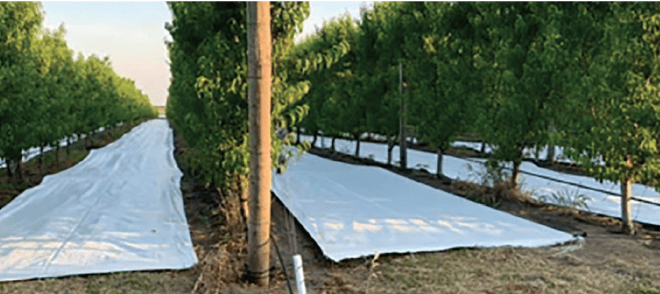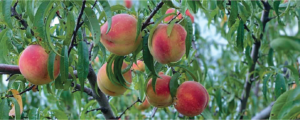
Apr 12, 2021Kansas peach grower puts focus on high-density output
A trained engineer has a head start in any profession in which ingenuity and mechanical aptitude breeds success. Gabe Spurgeon, manager of South Baldwin Farms near Baldwin City, Kansas, is a prime example of how that type of pedigree can pay dividends.
As was profiled in an article by Ron Wilson, director of the Huck Boyd National Institute for Rural Development at Kansas State University, Spurgeon, a Missourian, met his wife, Katelyn, in honors college while they were attending Pittsburg State in Kansas. He earned degrees in math and physics and worked for engineering firms in Joplin, Missouri, and Pittsburg, before they moved to Baldwin City to be closer to her family.
As a youngster, Spurgeon worked in peach orchards during the summertime. After graduating from college, he found he didn’t enjoy working inside at a desk.
“I began in a Missouri peach orchard at age 13, and later became a restless engineer for eight years,” Spurgeon said.


His father-in-law, David Miles, had purchased a farm south of Baldwin City in 2000 and was haying it but had always been interested in having a commercial orchard. They decided to devote part of the farm to the orchard with Spurgeon doing the day-to-day management. The first apple trees were planted in 2015, with peach and more apple trees and other products following.
Today, South Baldwin Farms has some 36,000 trees. The farm produces apples, peaches, nectarines and blackberries, with cherry trees coming into production soon. South Baldwin Farms has an 11,000-square-foot facility including a retail storefront, packing facility and 2,400 square feet of cold storage. The farm has a pumpkin patch and a seasonal U-pick operation as well.
The operation intends to expand its apple acreage from the current 15 to 55 acres by 2023.
“The engineer side of my brain is always looking for a better way to do things,” Spurgeon told Wilson for the profile story. For example, he chose to grow dwarf trees which produce quality apples quicker. They are grown in high density, which saves land and labor.
“In 2019, we got 500 bushels per acre on some three-year-old trees,” Spurgeon said. “We’re quickly becoming the biggest tree-fruit producer in Kansas.”
Spurgeon continues to innovate. “We went to Australia to learn about high density peaches,” he said. The farm conducted large-scale trellis planting from 2016-19.
“We got a Kansas Department of Agriculture specialty crop block grant to do a field trial on using netting over our trees which is supposed to protect from hail, windburn, sunburn and bird damage,” he said. Through another project, they have found that reflective fabric on the ground can help develop the color of the fruit.
The farm’s blackberries are grown on a rotating trellis, which allows easier harvest, more sun where needed and protection when it is not needed. “Our sun scald used to be 5 to 10%,” he said. “Now it’s virtually zero.”
“We have our blackberries on rotating trellis of our own design,” Spurgeon told Fruit Growers News. “It’s probably the thing on the farm I’m most proud of.”
Spurgeon and his wife have three children: sons Grayson, 8, and Thomas, 6; along with 2-year-old daughter Olivia.
Michigan peach meeting guest
Spurgeon took time out in March to be a featured speaker at the Michigan Spring Peach Meeting, held virtually.
“It turns out I’m not made to work behind a desk, so I had a discussion with my father-in-law about expanding the hobby farm into a more serious business venture,” Spurgeon told those attending the peach meeting. “In 2012, we planted what we called a test orchard (of peaches), where we just have a half-acre of trees where we can try something new. That’s where we got our feet wet in the high-density approach.”
“We only have so many years of experience on this, so don’t take this as a proven method by me,” Spurgeon cautioned his audience of peach growers. “(Australian growers) have been doing this for decades, and it is proven down there. The reason they have been doing it down there is because their labor costs are equivalent to over $20 an hour U.S. They are doing everything they can to get labor out of the question, and that is one thing that this system does.”
Spurgeon said South Baldwin Farms has 35 acres of tree fruit in production – mostly apple, peaches and some nectarine. “We’ve lost our peach crop last year to late frost, and this year to the Arctic blast in February, so we’re unable to show yield potential (with the high density peach system). However, there’s no doubt that harvest is easier and quicker.”
Innovating with test orchard
The farm planted 16 acres of peaches and apple in its commercial orchard in 2016, getting it completely filled in 2019.
“Just by our nature we are interested in progressive techniques,” Spurgeon said. “Since we’re not a multi-generational farm, we’re not entrenched in our ways. Our hobby orchard was more open-vase trees, and we have about 15 trees left from that orchard that are 20 years old and not in that good of shape.”
Seeking to move toward a more two-dimensional tree training system, Spurgeon and Miles visited Australia, “learning quite a bit in just four days.”
South Baldwin Farms had already had success marketing its products. “We sell everything we can in the store that’s on the farm because that is where the best margins are,” Spurgeon said. “Then we progress to lower margins, selling to other farms, direct to grocery stores and to a regional distributor that makes up about 50% of its sales volume.
“We sell some of our seconds in peaches and blackberries, and apple seconds are 100% used for ciders and bakeries that pay retail for them,” he said.
“I went with a lot of tried and true (peach) varieties when we planted our orchard,” Spurgeon said. They include Haven varieties, like Red Haven and Cresthaven; Stellar series, including Allstar, and four PF (Paul Friday) selections. Nectarine varieties grown by South Baldwin Farms include Fantasia, Hardired and Sunglo. The season in Kansas runs from June 20-Sept. 5.
Why high density?
“It’s basically the same discussion you would have in apples, but there are a couple of variables,” Spurgeon said. “Peaches have a more uncertain crop, so it’s understandable why someone would not want to do that higher upfront capital investment because there is a risk of losing the crop.”
While an earlier return on investment (ROI) opportunity may exist with high-density production, there’s a significant risk “that whenever you start losing crops, you aren’t getting the ROI as easily,” he said.
“One of the things I like is the harvest labor efficiency,” Spurgeon said. “We have never used a ladder in our commercial orchard, and don’t see a reason to. We use our platform for everything up high. It also simplifies the work convention, being two-dimensional. It’s just a more simple structure.
“It’s easier to develop instructions on how to care for that tree – how to thin it,” he said. “Because you’ve got windows within the trellis, and have a very defined leader, they are mostly uniform scaffold limbs in size. It’s just easier to give work instructions.”
“Something we hope to try this year is hedging, both top and side,” he said. “I feel that I get better spray coverage with our tower sprayer on a much narrower canopy. I’ve been able to back off on my chemical usage without any negative effects.”


High-density challenges
“It’s a much higher establishment cost,” Spurgeon said. “It does require some timely attention as the tree grows, especially if you are going to a multi-leader system. You need to train for getting the correct angles. Otherwise, they end up colliding between trees, for lack of a better term.
“Summer pruning is necessary,” he said. “We’ve proven that by not summer pruning and getting absolutely no fruit in the lower half of the tree. Light is very important on these type of systems, as it is in every system, but even more so when you’re pushing the envelope on density.”
Summer pruning for light inception takes place in mid-July in Kansas. Breaking off tall branches in the tops seems effective in slowing growth in that area. Spurgeon suggests pruning water sprouts to stubs in the bottom of the tree. “We do not do this (summer pruning) for red fruit, but it can be a benefit for some regions with more market competition.”
Spurgeon also advocated root pruning for growth management, focusing on 30-36 inches from the tree on one side, done between petal fall and shucksplit.
The farm has experimented with Extenday for low fruiting development, he said.
— Gary Pullano, editor














